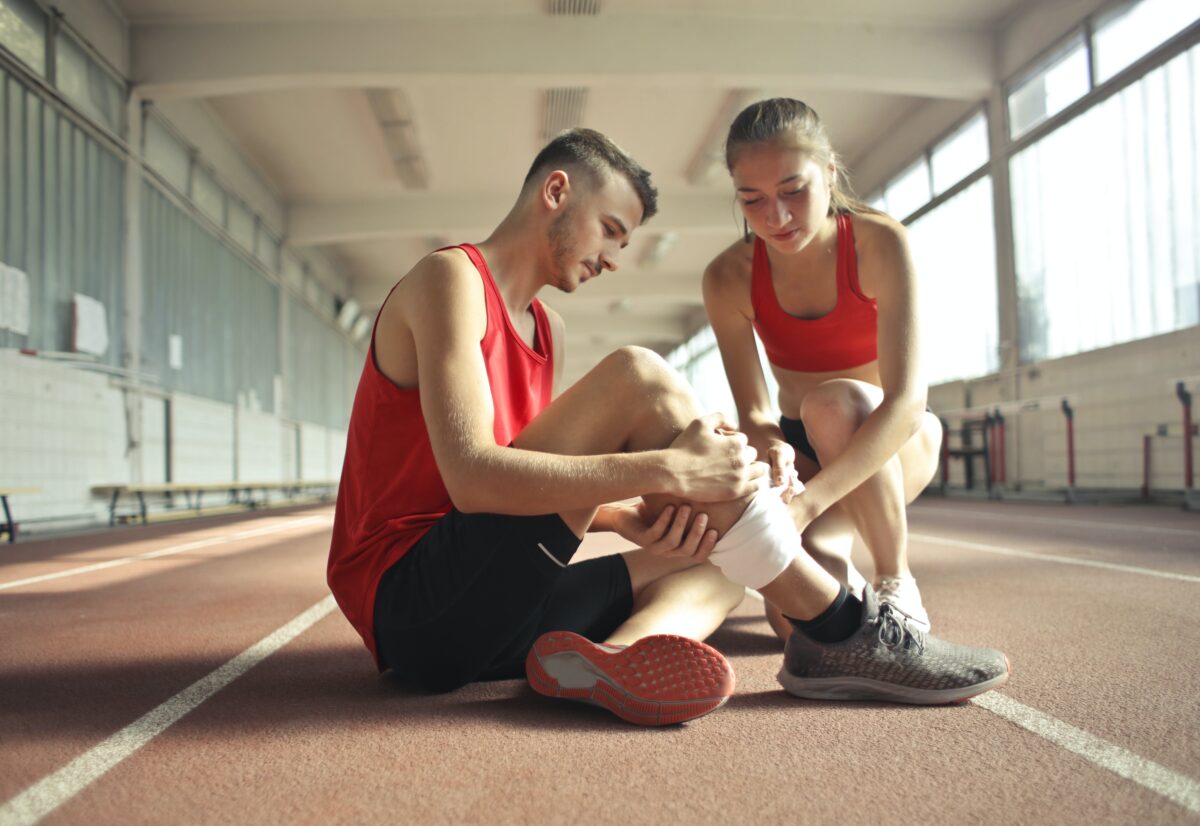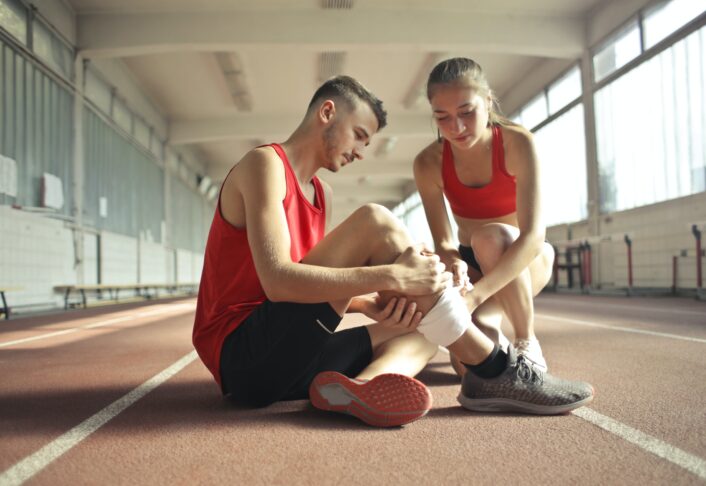The Genetics of Injury Predisposition
Aira
on
February 9, 2024

Latest Posts
Table of Contents
The Genetics of Injury Predisposition
Date of Content: January 18, 2024
Written by: Harvey Talento
Reviewed by: Maarit Tiirikainen, PhD
What is Injury Predisposition?
Injury predisposition refers to an individual’s increased susceptibility or likelihood of experiencing injuries, whether they are acute or chronic. While some injuries may result from accidents or unforeseen events, certain factors contribute to a person’s vulnerability to specific injuries. Understanding injury predisposition involves exploring the complex interplay of genetic and non-genetic factors that influence an individual’s risk of sustaining injuries.
Injury predisposition is rooted in the unique genetic makeup and environmental influences that shape an individual’s anatomy and physiology. It goes beyond the idea of accidents or external forces alone, delving into the intrinsic characteristics that may make certain individuals more prone to particular types of injuries.

Why Understanding Predisposition Matters
Recognizing and understanding injury predisposition is crucial for several reasons. It allows for targeted preventive measures, personalized fitness planning, and early intervention strategies. Whether in sports, workplace safety, or daily activities, acknowledging one’s predisposition to certain injuries empowers individuals to make informed choices that can mitigate risk and enhance overall well-being.
Common Types of Injuries
Injuries are a common occurrence in our daily lives, and they can range from minor inconveniences to major health concerns. Understanding the common types of injuries and their predispositions can help us prevent and manage them effectively.
Sprains and Strains
Sprains and strains are common injuries that can happen suddenly. They occur when the ligaments (sprains), muscles, and tendons (strains) are stretched or torn. Some people might be more likely to get these injuries due to their “genes”, but things like not warming up properly, using the wrong technique, or bad environmental conditions can also cause them. It is important to consider these genetic and environmental factors when trying to prevent these injuries.
Fractures
Fractures, or broken bones, can also have a genetic component. Some people might have genetic variants that make their bones less dense or strong, making them more likely to break. But fractures are often caused by things like accidents, falls, or trauma. So, it’s important to understand how these genetic and environmental factors work together when preventing fractures.
Concussions
Concussions are a type of brain injury that’s often caused by a blow to the head. There might be genetic factors that make some people more likely to get concussions, but things like sports injuries, accidents, or falls often cause them. Because concussions can be complex, it’s important to understand both the genetic and environmental factors that can contribute to them.
Overuse Injuries
Overuse injuries are different because they happen over time, not all at once. They’re caused by making the same motion over and over again, which puts stress on the body. Some people might be more likely to get these injuries because of their genetics, like if they have certain variations in their joints or muscles. However, the repetitive motions that cause these injuries are often due to sports or work activities.
By understanding these common types of injuries and the factors that contribute to them, we can take a more personalized approach to preventing and managing them. This means considering our genetic makeup and the things in our environment that can cause injuries.
Genetics of Injury Predisposition
Understanding the role of genetics in injury predisposition is a critical aspect of sports science. This section explores the direct link between an individual’s genetic makeup and their susceptibility to sports-related injuries.
Shoulder Impingement Syndrome (SIS)
A study investigating the genetic roots of Shoulder Impingement Syndrome (SIS) discovered strong associations with specific genes. Notably, an ANXA1 gene SNP rs750968 on chromosome nine showed a significant link to SIS. Multiple other SNPs within ANXA1 and candidate loci in PLGRKT and PIK3AP1 also demonstrated suggestive associations.
Ankle Injuries
Research on ankle injuries has also employed genetic analysis, revealing noteworthy associations at specific loci on chromosomes 21 and 9. These areas are close to genes (such as COL18A1 and NFIB) related to tendon and ligament structure. Achilles Tendon Injury
A comprehensive study involving over 12,000 cases of Achilles tendon injuries identified 67 significant genetic markers. These markers were linked to three chromosomal regions containing genes like CDCP1/TMEM158, MPP7, and SOX21/GPR180. Musculoskeletal Soft Tissue Injuries
A meta-analysis investigating the COL5A1 gene variant (rs12722) established a significant association with musculoskeletal soft tissue injuries, especially in Caucasians. Individuals with the TT genotype faced a higher risk of injuries to tendons and ligaments, including those affecting the Achilles tendon, anterior cruciate ligament, and tennis elbow.
Genome-Wide Association for Rotator Cuff Injury
A large-scale genome-wide study involving over 8,000 cases explored genetic factors in rotator cuff injuries. It pinpointed the rs71404070 SNP near the RPS27AP16 gene as significantly associated with rotator cuff injuries.
General Sports Injuries Risk
A meta-analysis focused on the COL1A1 rs1800012 polymorphism and its link to sports-related tendon and ligament injuries. The study, including 933 cases and 1,381 controls, highlighted a significant association in specific genetic models. This suggests a potential role for this genetic variant in predisposing individuals to certain sports-related injuries, particularly those affecting the anterior cruciate ligament (ACL).
All this information highlights the growing understanding of genetic influences on injury predisposition. While further research is necessary, this knowledge empowers individuals to adopt proactive strategies for injury prevention and maintain a healthy, active lifestyle.
Non-Genetic Factors Influencing Injury Predisposition
When it comes to sports and physical activities, many things can make us more likely to get hurt. Let’s look at these factors to understand better how to avoid injuries.
Personal Factors
- Age: Age is an important factor. Young athletes and those who are getting back into sports are often more likely to get hurt.
- Gender: Men and women can have different injury risks. Some injuries are more common in men, while others are more common in women.
- Body Type: Muscle imbalances, weakness, and lack of flexibility can make us more likely to get hurt. This shows why it’s important to stay in good shape.
Outside Factors
- Training Errors: Overtraining, inadequate warm-up, and improper technique are external factors that significantly elevate the risk of injuries, underscoring the importance of well-rounded training practices.
- Equipment: The gear we use matters; worn-out or ill-fitting equipment can amplify the risk of injuries, highlighting the need for proper gear maintenance.
- Playing Surface: The surface on which activities take place matters. Uneven or slippery surfaces contribute to increased injury risk, emphasizing the role of environmental factors.
- Environmental Conditions: Extreme weather conditions, be it heat, cold, or humidity, can heighten the risk of injuries, prompting the need for adaptability in various environments.
- Psychological Factors: Stress, anxiety, and fatigue are psychological factors that can influence injury susceptibility, emphasizing the interconnectedness of mental and physical well-being.
Understanding these personal and outside factors can give us a full picture of injury risk. It’s important to remember that these factors can vary from person to person and from sport to sport. By considering these factors, athletes can make informed decisions and work towards a safe and balanced athletic journey.
Prevention Strategies
Injury prevention is a comprehensive effort that includes risk assessment, hazard analysis, and inspection of the environment to prevent or minimize the severity of physical injuries before they occur. Here are some strategies for preventing injuries:
- Proper Training and Techniques: Many injuries stem from a lack of training, improper practices, or the incorrect use of sports gear. Investing time in appropriate training and using the right techniques can significantly lower the risk of injuries.
- Warm Up and Cool Down: Prepare your body for action by incorporating light exercises like stretching or gentle cardio workouts. This helps prime your body for impact, reducing the likelihood of injury.
- Use of Safe, Properly-Fitted Equipment: Ensure that your gear is safe and fits you well.
- Developing a Strengthening and Balance Program: Building physical resilience through targeted strengthening and balance exercises can be a significant factor in injury prevention.
- Wearing Appropriate Footwear: The right shoes can be your best defense against slips, trips, and falls.
Injuries don’t occur randomly; they follow a pattern similar to how diseases develop. By identifying and assessing potential dangers, we can actively reduce the chances of injuries occurring in the first place. Taking these preventive measures seriously can save us from potential troubles in the future.
About the LifeDNA Fitness Report
Discover the secrets within your genes using the LifeDNA Fitness Report, a comprehensive guide that unveils your unique genetic makeup and sheds light on your injury predisposition. Gain valuable insights into how your genetics may influence specific injury risks and receive personalized recommendations for a holistic approach to well-being.
Injuries may feel unpredictable, but the LifeDNA Fitness Report empowers you with foresight. Understand your genetic predispositions, proactively prevent injuries, and elevate your health.
Invest in your well-being today!
Summary
- Injury predisposition refers to an individual’s increased vulnerability to specific injuries, influenced by genetic and non-genetic factors, shaping their susceptibility to acute and chronic injuries.
- Recognizing and understanding injury predisposition is crucial for targeted preventive measures, personalized fitness planning, and early intervention strategies, empowering individuals to make informed choices in various aspects of life.
- Injuries, ranging from minor inconveniences to major health concerns, are a prevalent part of daily life. Understanding these common types and their predispositions enables effective prevention and management strategies.
- Sprains and strains result from sudden trauma and may have genetic components influencing ligaments and tendons. Non-genetic factors like improper warm-up or technique also play a significant role in these injuries.
- Fractures or broken bones may have genetic predispositions related to bone density. However, accidents, falls, or trauma are common causes, emphasizing the importance of both genetic and environmental factors.
- Concussions, linked to head injuries, may have genetic contributions, but sports injuries, accidents, or falls are predominant causes. Understanding both genetic and environmental factors is crucial for comprehensive prevention.
- Overuse injuries, developing over time, relate to repetitive stress. Genetic factors in joint or muscle development may contribute, but the repetitive motions in sports or work activities are key triggers.
- Exploring genetic predispositions reveals associations like the ACTN3 gene with muscle damage susceptibility and COL5A1 variants linked to soft tissue injuries. This knowledge enables proactive injury prevention strategies tailored to individual genetic profiles.
- Personal factors like age and gender, combined with external factors such as training errors, equipment quality, playing surface, environmental conditions, and psychological factors, contribute to injury susceptibility.
- Injury prevention entails a comprehensive effort, including risk assessment, hazard analysis, and environmental inspection. Strategies encompass proper training, warm-up, equipment use, strengthening programs, and wearing appropriate footwear, emphasizing the importance of proactive measures for a safe and balanced lifestyle.
References
- https://academic.oup.com/g3journal/article/10/9/3279/6060131
- https://journals.plos.org/plosone/article?id=10.1371/journal.pone.0185355
- https://journals.lww.com/acsm-msse/fulltext/2021/08000/identification_of_three_loci_associated_with.23.aspx
- https://www.oncotarget.com/article/23805/text/
- https://journals.plos.org/plosone/article?id=10.1371/journal.pone.0189317
- https://www.oncotarget.com/article/15271/text/
- https://pubmed.ncbi.nlm.nih.gov/7481278/
- https://www.niams.nih.gov/health-topics/sports-injuries
- https://www.niams.nih.gov/health-topics/sports-injuries
- https://www.niams.nih.gov/health-topics/sports-injuries
- https://www.niams.nih.gov/health-topics/sports-injuries
- https://www.ncbi.nlm.nih.gov/pmc/articles/PMC4183252/
Customer Reviews




*Understanding your genetics can offer valuable insights into your well-being, but it is not deterministic. Your traits can be influenced by the complex interplay involving nature, lifestyle, family history, and others.
Our reports have not been evaluated by the Food and Drug Administration. The contents on our website and our reports are for informational purposes only, and are not intended to diagnose any medical condition, replace the advice of a healthcare professional, or provide any medical advice, diagnosis, or treatment. Consult with a healthcare professional before making any major lifestyle changes or if you have any other concerns about your results. The testimonials featured may have used more than one LifeDNA or LifeDNA vendors’ product or reports.
- Category: Fitness



